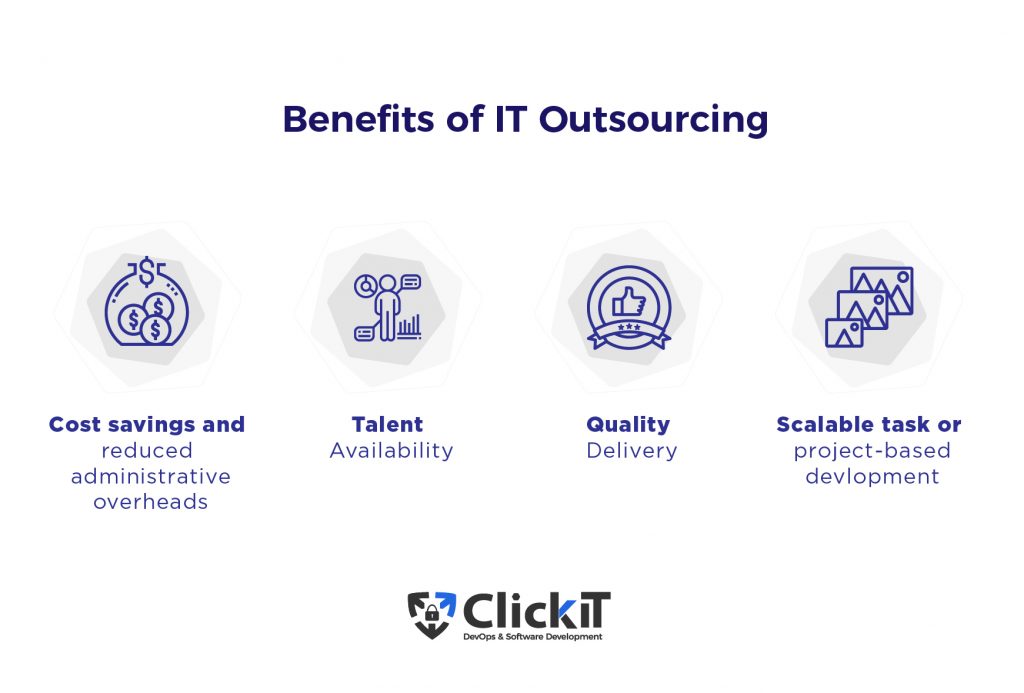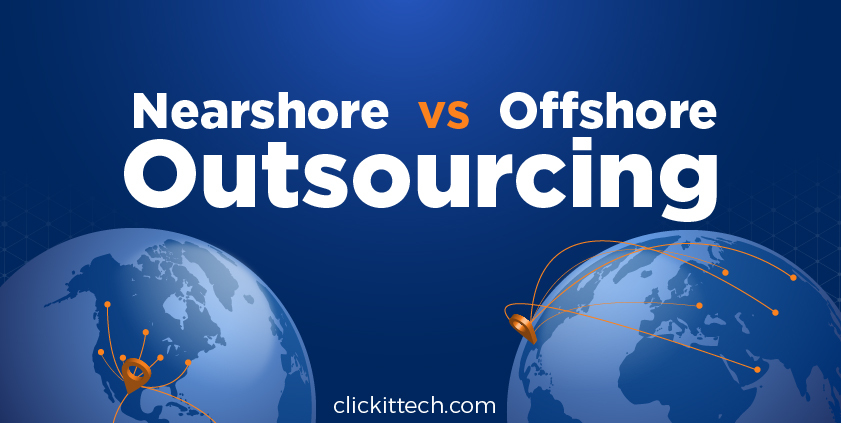Are you choosing between nearshore vs offshore? Both options have significant pros and cons, so making a decision may take some serious effort. This article will try to ease the task and give you all the essential data.
So, let’s explore the differences between nearshore and offshore software development, their advantages and disadvantages, and the guiding principles involved in choosing one over the other.
However, before we get to it, let’s better understand the big picture: Why should a business opt for outsourcing in the first place?
- Nearshore vs Offshore: Collaboration and Communication
- Nearshore vs Offshore: Decision-Making and Operations
- Nearshore vs Offshore: Task Complexity
- Nearshore vs Offshore: Experiences to consider
- Nearshore Outsourcing Benefits
- What are the Disadvantages of Nearshore?
- Offshore Outsourcing Benefits
- What are the Disadvantages of Offshore?
- Nearshore vs Offshore: Which one should you choose?
- FAQs
Nearshore vs Offshore: Collaboration and Communication
Nearshore
- Frequent visits and monitoring
Easier for management to conduct on-site visits and face-to-face meetings, fostering closer collaboration. - Real-time communication
Synchronized working hours and cultural proximity make real-time communication more seamless, improving teamwork.

Offshore
- Infrequent site visits
Visits are limited, making it more challenging for ongoing physical oversight and in-person collaboration. - Minimal real-time collaboration
Time zone differences and cultural gaps may limit real-time interaction, with reliance on asynchronous communication.
Nearshore vs Offshore: Decision-Making and Operations
Nearshore
- BPO and KPO requiring a lot of decision-making
Suitable for business processes that demand continuous, hands-on decision-making and strategic input. - Complex software development
Best for projects where frequent adjustments, innovation, and collaboration are essential, ensuring better quality outcomes.
Offshore
- Straightforward software development
Works well for well-defined projects with minimal scope changes and limited need for ongoing decision-making. - Transactional tasks with clear workflows
Effective for simple, repetitive tasks like maintenance and IT support that don’t need deep collaboration or decision-making.
Nearshore vs Offshore: Task Complexity
Nearshore
- Complex software projects
Ideal for complex, high-value projects where collaboration and flexibility are needed to address challenges in real-time. - Projects requiring 24/7 support
Particularly effective for support functions when time zones align, allowing teams to provide real-time, around-the-clock service.
Offshore
- Routine IT tasks
Offshore is best for tasks such as system maintenance, data entry, and support that can be handled with minimal oversight. - Cost-efficient, low-complexity projects
Great for simple, well-documented projects where the focus is on reducing costs over close coordination.
Nearshore vs Offshore: Experiences to consider
1. Daily scrum meetings: Do you imagine yourself having daily calls at 5:00 or 6:00 a.m.? Pacific to sync with an offshore team?
2. Problems in the middle of the day: Let’s say a problem occurs at 2:00 p.m. PT while the offshore team is sleeping. You would have to wait eight to ten hours to resolve the emergency.
3. Urgent tasks: Imagine having an urgent task every other day, but you have to wait for the next day to resolve it, which means lower productivity.
4. Long calls: Imagine having a call to explain a code issue with a long presentation showing the code. If you are doing it in the middle of the day, that would be possible. But you should have live collaboration for three to four hours at most, or that’s bad for productivity.
5. Culture: Mexico is known for its happiness, excellent customer service, and rich culture.
Nearshore vs Offshore Summary Table
| Criteria | Nearshore | Offshore |
| Travel accessibility | 1.5- to 5-hour flights | 30-hour flights, plus extra costs of sleeping arrangements |
| Real-time collaboration | Possible, same time zone | Harder to arrange due to 7- to 10-hour time zone differences |
| Cultural affinity | Very similar | Most offshore outsourcing destinations are in Asia and Africa; both have vastly different cultures to North America |
| Project security | WTO, WIPO, PCT, and USMCA agreements | Some agreements don’t apply |
| Project costs | $25 – $50 per hour | $15 – $100 per hour |
Nearshore Outsourcing Benefits
Outsourcing, like any other business decision, comes with its bag of benefits and drawbacks. In this section, let’s highlight the parameters on which the derived benefits greatly offset its perceived drawbacks.
Cost savings and reduced administrative overheads
There is no argument about the fact that nearshore vs offshore outsourcing both result in cost savings. It gives you access to a large pool of skilled software professionals who demand less than half the rate you would typically pay an American or Canadian developer.
Hiring and training an in-house team also requires scaling up your office space, providing other logistics, provisions for salary and benefits, and allowing them time to sync with the office environment before they can start delivering. Outsourcing allows you to bypass all of these since your tech partner already has all the logistical requirements and a trained workforce that can start delivering from day one.
Talent availability
Except for cost optimization, the independence from your geographic location brings you another benefit, the possibility to find and hire the best talent from all over the planet.
Developed countries have a demand-supply mismatch of skilled professionals. It’s not to say that the U.S. and Canada don’t have skilled professionals — but they don’t have enough to cater to market demands.
If a particular type of IT specialist isn’t available or a programming language isn’t so popular in your area, an offshore specialist or team may bring immense value to your project. Relocation is troublesome and expensive, and outsourcing is a much easier solution.
Hire our nearshore staff augmentation services to have expert engineering teams in your project!
Quality delivery
While selecting your outsourcing partner, you entrust skilled professionals with your projects. They have years and decades of experience and can get it right the first time while keeping up with the quality standards.
On one hand, it ensures you get quality work delivered, and on the other hand, it saves you time, cost, and effort in building that capability in-house by conducting extensive recruitment drives and interviewing people on skills you know little about.
Scalable task or project-based development
As outsourcing contracts are project-specific, you can scale your workforce up and down according to your work volumes. You also have the flexibility to choose different vendors as and when required. Additionally, you don’t need to keep a software development team on your payroll once the work is finished.
Minimal cultural difference
When work is outsourced to a neighboring country, cultures are broadly similar. It is easier for teams to blend with each other and collaborate. This makes for speedy communication, and interactions are more productive, improving the efficiency and quality of deliverables.
Similar time zone
Given geographical proximity, the working hours of clients and vendors overlap to a large extent. It simplifies real-time collaboration. This makes it easier to:
✔ Schedule meetings
✔ Have more fruitful interactions
✔ Solve problems faster
✔ Get more value for your budget
✔ Move the project on schedule
Shorter business trips
Nearshore locations are located within two to three hours of flying time. Thus, your business trips would be shorter, less expensive, and more productive.
Higher security and easier audits
Nearshoring your development projects gives you closer control of your intellectual property. You and your vendor would be subject to similar data protection laws, which makes it easier to draw up contracts and enforce confidentiality during and after the project.
Read our blog Nearshore Software Development Company: Essential Characteristics to make an informed decision about nearshore.

Despite the benefits, outsourcing comes with its own set of challenges, but they are specific to the type of outsourcing you consider. In the next sections, let’s examine nearshore vs offshore outsourcing in greater detail and analyze the pros and cons of each.
Read the blog about the 6 reasons why your DevOps team in the same time zone is more productive!
Why Choose Mexico for Nearshore in USA and Canada?
Nearshore software development offers the perfect mix of onshore and offshore benefits. Minimal cultural differences and reduced labor costs are key to streamlining your remote teams with project requirements.
Why is Mexico a preferred nearshore destination for clients located in the U.S. and Canada? In addition to offering the general benefits of nearshore outsourcing, Mexico’s unique location and demographics offer the following benefits to American and Canadian clients:
You can read our slideshow to learn How to Choose the Best Nearshore Company.
Cost benefits
Mexico offers software development services at $25 to $50 per hour, plus agency fees. When compared to the U.S. and Canada, where hourly costs start at $75 and can reach as much as $850 for enterprise-level projects plus agency fees, this is a considerable bargain.
Agency fees are an obvious and transparent part of dealing with any company, and they will increase the closer you get to home. However, if you’re hiring in-house, it’s not just the hourly pay you should be aware of but also some hidden costs. Consider this:
✔ The total cost of hiring a new employee in-house can cost from $4,000 up to $8,000, according to official sources.
✔ Replacing an in-house employee can cost up to 60% of an annual salary.
✔ You might be losing 1% to 2.5% of revenue in the time it takes you to hire an in-house worker.
When you look at in-house versus outsourcing, the latter is a more appealing option. So, let’s take a closer look at the different prices per specialization to see the big picture of nearshore vs offshore.
| Onshore* | Nearshore** | Offshore | |
| Senior DevOps | $65 – $120 | $35 – $60 | $25 – $50 |
| Middle DevOps | $50 – $80 | $30 – $45 | $15 – $35 |
| Junior DevOps | $40 – $50 | $20 – $25 | $15 – $20 |
| Business analyst | $110 – $205 | $20 – $40 | $20 – $50 |
| Architect | $100 – $290 | $40 – $80 | $35 – $100 |
| Project manager | $60 – $200 | $20 – $60 | $20 – $50 |
| Junior developer | $40 – $60 | $20 – $30 | $10 – $25 |
| Middle developer | $50 – $80 | $25 – $45 | $20 – $50 |
| Senior developer | $65 – $130 | $35 – $60 | $25 – $60 |
| Lead developer | $70 – $180 | $50 – $70 | $30 – $70 |
| Junior QA | $35 – $50 | $15 – $25 | $15 – $70 |
| Middle QA | $40 – $70 | $20 – $35 | $20 – $80 |
| Senior QA | $60 – $100 | $30 – $55 | $20 – $80 |
| Junior UX/UI designer | $45 – $70 | $15 – $25 | $20 – $50 |
| Middle UX/UI designer | $55 – $80 | $20 – $35 | $20 – $65 |
| Senior UX/UI designer | $65 – $120 | $30 – $55 | $25 – $80 |
| Graphic designer | $50 – $100 | $15 – $40 | $10 – $35 |
As you can see, offshore prices range quite vastly. However, nearshore prices are easier to predict.
*Onshore: These prices exclude labor benefits for on-shore pricing, which would increase the hourly rate to approximately 15% to 20% more. These prices might be modified on the onshore model due to common labor benefits organizations offer in the USA, like general insurance, PTO, vacation payments, off days due to sickness, dental insurance, 401K for retirement, free lunches, etc. At the time of including such benefits, the price range would considerably increase.
Favorable time zones
Mexico spans four time zones that closely mirror the time zones of the U.S. This allows you to schedule meetings during regular office hours. You do not need to worry about waking someone up too early (as is the case with offshore countries) or ruining someone’s evening plans. Interactions are more direct, brainstorming sessions will be more productive, and problem-solving happens in real-time rather than sending emails and waiting for a response the next day.
Large talent pool
Mexico has taken decisive steps toward producing technical graduates, and the results are already showing. STEM courses have become popular at the high school level itself. Mexico matches the U.S. when it comes to producing skilled computer science graduates, with over 120 universities offering technical education.
High English level
Proficiency in English widely varies in Mexico depending on the industry and location. It’s not the most popular language in the country (when you come as a tourist, you’d better learn some Spanish), but in IT, there’s a large number of professionals who speak English at a very high level, often close to native.
Supportive government policies
The Mexican government has continuously invested in the IT infrastructure with the aim of producing high-level software technology parks. Monterrey Technology Park, Apodaca Technology Park, and Guadalajara Software Center have all been developed recently, offering world-class facilities.
Guadalajara is touted as Mexico’s “Silicon Valley,” with a workforce of over 115,000 and growing. It has already attracted tech giants such as Amazon and Oracle. Saltillo is another famous place, a hub for DevOps and software development opportunities.
IPR protection
Mexico has a robust regulatory regime for Intellectual Property Rights protection. It supports international agreements stipulated by the WTO (World Trade Organization), WIPO (World Intellectual Property Organization), and PCT (Patent Cooperation Treaty).
There’s also the USMCA (United States-Mexico-Canada Agreement), also known as T-MEC in Mexico. The agreement supports the economy, trade, and intellectual property in North America and creates a more level playing field for workers.
Cultural Closeness
Cultural affinity is a contributing factor in communication and collaboration. Even though Mexican culture has certain differences from USA and Canada, they are easy to overcome, and people have a similar way of looking at things in business.
Thus, cultural closeness will help understand the requirements and needs of each party has – and receive the expected result.
Personal interaction opportunities
In stark contrast to the 30-hour ordeals involved in reaching India or China, flying to Mexico from U.S. mainland airports takes much less time and energy. For example, a trip from LAX to Saltillo will be six hours and 45 minutes, to Monterrey just about one and a half hours; from Dallas to Monterrey three hours and 40 minutes; from Chicago to Monterrey five hours and 45 minutes; and from New York City to Monterrey just shy of seven hours.
On average, the journey takes about half the time compared to offshore regions. You can definitely have a meeting in person, go back, and sleep in your own bed within 24 hours.
Continuous professional development
The Mexican workforce is eager to learn and upskill. In addition to technology learning, they also learn soft skills that enable them to communicate professionally with global clients.

What are the Disadvantages of Nearshore?
Cost
You still save costs compared to onshore or in-house, but your hourly billables would be higher compared to offshore vendors. You have to do extra due diligence regarding the quality of work and vendor capabilities to ensure the quality of deliverables would be worth the added cost.
Fewer vendors
Nearshoring reduces your choices when it comes to choosing vendors. As your talent pool is reduced, you might have difficulty finding your project’s skilled professionals.
To learn more about nearshore, read our blog What is a Nearshore Company? to make the right choice.
**Nearshore: On the other hand, nearshore pricing includes all labor benefits. In the case of Mexico, we cover life insurance, yearly bonuses, performance bonuses, free training, extra bonuses and awards, and much more.
Offshore Outsourcing Benefits
When an organization delegates its software development (or any other process) to a team located in a faraway country with a considerable time zone difference, offshore outsourcing comes into the picture. Though there are quite a few advantages, cost savings is a major motivation behind offshoring, as software professionals in developed economies like the U.S. and Canada have high wage demands.
Cost savings
Software professionals belonging to far-off offshore destinations such as India, Russia, Ukraine, China, and the Philippines are available for less than half the hourly wages compared to those located in the U.S., Canada, and other developed countries.
Global talent pool
ou can choose your offshoring destination based on your talent requirements. Offshore destinations have seen a spurt in training institutions imparting professional technical courses such as engineering, mathematics, science, and technology.
Rotating shifts
Offshore professionals are available to work the shifts their clients want them to. This ensures an overlap of working hours (like in nearshore countries) and a quick turnaround.
What are the Disadvantages of Offshore?
Time zone differences
For clients located in the U.S., the time zone difference is usually around 10 to 14 hours. This is not easy to overcome, and the working hours overlap to a lesser extent. It affects the frequency and quality of meetings, ultimately affecting project deliverables.
Cultural barriers
Offshore countries have a diverse mix of native people, and their cultures are vastly different from the U.S. Barring a small percentage of professionals who are sufficiently trained or have enough experience in working with western clients, cultural barriers can be too much to overcome for remote teams.
Quality issues
Given the distance, it may be difficult to verify the capability of vendors and check their internal processes. A large number of IT offices have mushroomed in these locations that do not have mature processes and are unable to meet the quality standards prevailing in the industry.
Travel
Traveling offshore means 15 or more hours of flying time. Besides being expensive, it is tiring on the mind and body. It translates into infrequent and long business trips and a reduced personal touch.
If you are looking to Outsource in LATAM, read our list of the top IT outsourcing companies in Latin America.
Nearshore vs Offshore: Which one should you choose?
In the discussion of nearshore vs offshore, we can see that Offshore outsourcing works well when costs are your prime concern, real-time collaboration is minimal, you have done it before, your internal processes are matured, and your expected deliverables are not complex.
Basic customer service, data entry, developing simple applications and websites, and infrastructure maintenance such as server patching, troubleshooting, etc. are the kind of projects that can be delivered well from offshore locations.
On the other hand, nearshoring helps overcome a few challenges posed by offshore outsourcing while retaining most of the benefits — it aims to deliver the best of both worlds.
Choosing between nearshore and offshore outsourcing options largely depends upon your budget and the nature of your project. When making the decision, it is important to crystallize your expectations in terms of budget, complexity, and real-time collaboration requirements.
If you are located in the U.S. or Canada and are looking for a nearshore partner for DevOps and other cloud-based IT consulting services, ClickIT is highly recommended by many companies across North America.
We have delivered over 2500 projects spanning multiple domains and technologies. We are also a part of the Amazon Web Services, Azure, and Google Cloud partner networks.
If you’re looking for skill, professionalism, and technical expertise, contact us for a quote.
FAQs
Outsourcing Software Development is the arrangement that takes place when a company delegates software development to a third-party company to reduce costs, have the best talent, and better quality delivery on projects.
Nearshore Outsourcing is the practice of delegating software development to a team located in a nearby country with a similar time zone. Nearshore has benefits like similar culture, real-time collaboration, and favorable time zones.
Offshore Outsourcing is the practice of delegating software development to a team located in a faraway country with a considerable time zone difference.
Mexico has many benefits of Nearshore software development, including cost savings, favorable time zones, a skilled and talent pool, a cultural affinity that contributes to better communication and collaboration, and shorter business trips.











